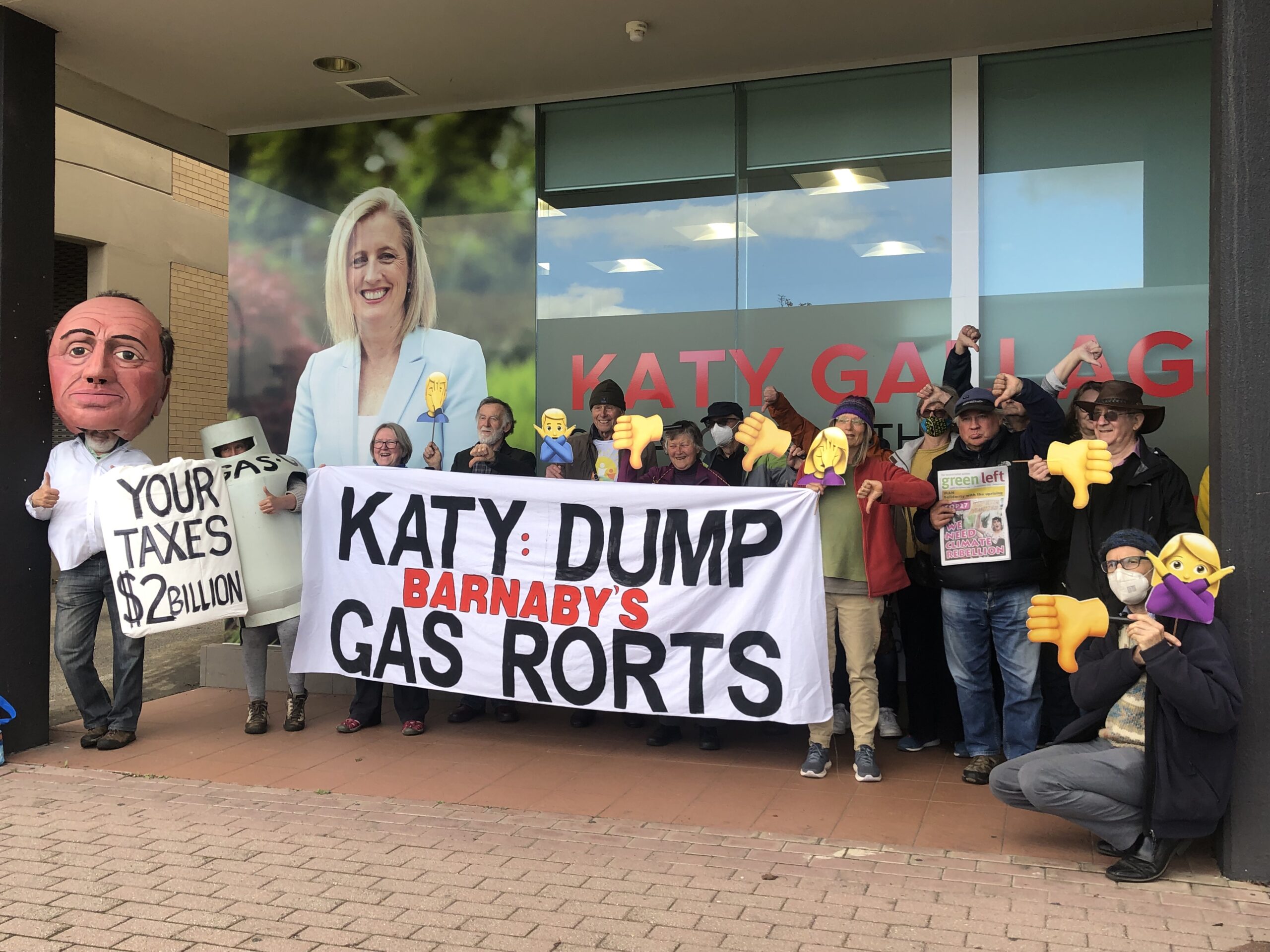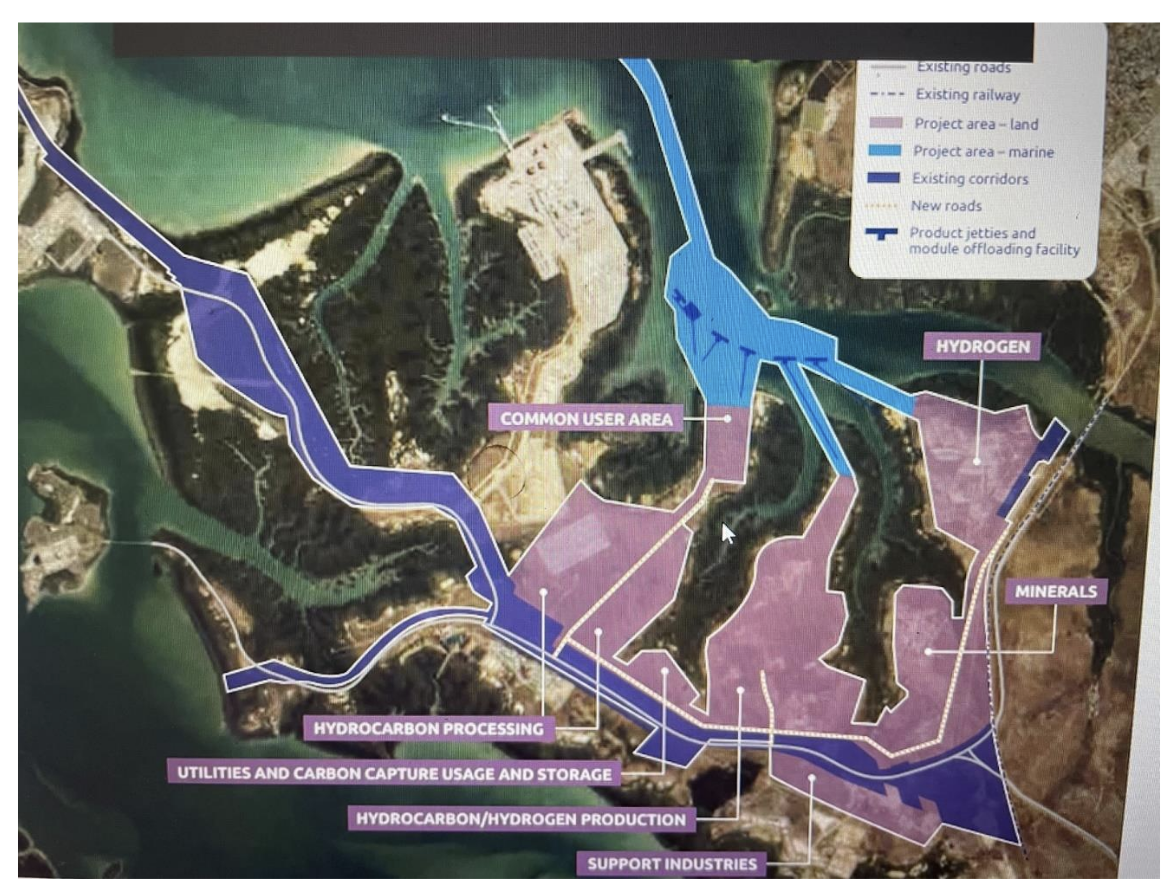Now we need our representatives to follow through on their promises.
Climate Minister Chris Bowen promised no new funding to gas projects. But Resources Minister Madeleine King and Infrastructure Minister Catherine King have committed the Albanese government to fund $2 billion for the polluting Middle Arm precinct in Darwin Harbour. This project was announced by Barnaby Joyce before the last Morrison Government budget – without any environmental, health or economic costings.
This so-called “sustainable” port facility would:
- cause serious local health and environmental impacts for Darwin, and
- drive up gas exports and exploitation of the Beetaloo Basin and Timor Sea gas reserves, contributing to dangerous climate change.
We know we face an accelerating climate emergency. In 2021 the International Energy Agency warned that the world cannot afford new coal, oil and gas projects. As UN Secretary-General António Guterres said in April this year, “investing in new fossil fuel infrastructure is moral and economic madness.”
November 2022 update
On Friday 14 October, more than 20 people, plus “Barnaby” and a human gas bottle, rallied outside Katy Gallagher’s Woden office, raising public awareness of the Middle Arm project and fossil fuel subsidies. We slipped a pile of letters and signed flyers under her door.
The federal budget update on 26 October was the first budget in years that took seriously the threat of climate change. However, funding for the Middle Arm project was confirmed.
And so this campaign will continue!
By the end of October, nearly 100 people had emailed Senator Gallagher, with copies sent to all ACT Senators and MPs. Senator David Pocock’s office responded that “David is extremely concerned about the Federal Government continuing fossil fuel subsidies and the Middle Arm development in particular”. David has written to both Finance Minister Senator Gallagher and Infrastructure Minister Catherine King about the issue, and raised it in Senate Estimates on Friday 28 October. He will “continue to prosecute the argument that any investment in Middle Arm be for building the capacity of Australia to be a hub for green energy into the future”.

Call on Finance Minister Senator Katy Gallagher to withdraw funding and commitment to the polluting fossil fuel Middle Arm project in Darwin Harbour.
Katy Gallagher Middle Arm gas subsidies
Email Finance Minister Senator Katy Gallagher to withdraw funding for Middle Arm gas precinct.
The PCA believes we need to act now to reach zero emissions at emergency speed.
More information about the Middle Arm project
‘Middle Arm’ is in the middle of Darwin Harbour, a few kilometres away from southern Darwin suburbs (including the city of Palmerston). It is the site of two existing LNG export facilities, run by INPEX (called Ichthys) and Santos (called Darwin LNG, which will be used to process gas from the controversial offshore Barossa project).
Companies and the NT Government are proposing to expand industry on Middle Arm to include more gas processing, including large new petrochemical facilities, minerals processing, CCS and hydrogen.
Despite recent NT Government rebranding of this industrial zone as the ‘Middle Arm Sustainable Development Precinct’, it is clear its primary function is to expand the gas industry and establish a petrochemical industry.
The picture below is from a recent NT government presentation. It shows that the majority of the precinct will be used for gas processing, hydrogen and carbon capture and storage, with small areas set aside for minerals processing.
If built, this zone would accelerate some of Australia’s biggest gas projects, becoming a foundational demand source for gas and other hydrocarbons from the Beetaloo Basin, or offshore in the Timor Sea.
The NT Government has been seeking funding to enable this zone. This follows a long and deeply murky history of corporate advocacy for this development, including through lobbyists installed into government advisory positions at both federal and NT levels.
Federal funding commitments
In a press release accompanying the last Coalition Budget in 2022, just before the election caretaker period, Barnaby Joyce announced over $7 billion in infrastructure funding. The keystone was $2 billion for Middle Arm, including:
- “1.5 billion to build new port infrastructure, such as a wharf, an offloading facility and dredging of the shipping channel, to boost the region’s importing and exporting ability…
- $300 million to support low emissions LNG and clean hydrogen production at Darwin, together with associated carbon capture and storage infrastructure.
- $200 million to further develop the Middle Arm Sustainable Development Precinct, delivering enabling infrastructure such as a rail spur and a new road network to strengthen supply chains.
A recent investigation by the Parliamentary Budget Office, for the Australian Greens, found that all of this funding was not contracted, meaning it can readily be cancelled or redirected without breaking contracts. Only the $300 million can be identified in the Budget Papers. The other funds appear to have been promised without actually committed in the Budget.
While the funding cannot be identified in the Budget Papers, it has since been re-endorsed by key Ministers in the Albanese government. The new Labor government has stated it will review all of Barnaby Joyce’s infrastructure funding with a view to cutting spending. Yet both Madeleine King, Minister for Northern Australia, and Catherine King, Minister for Infrastructure, have specifically re-committed to the Middle Arm funding.
At the same time, Chris Bowen, Minister for Climate and Energy, has stated that public funding will not be used to support fossil fuel projects, and it has been reported that Madeleine King’s fossil fuel “boosterism” is causing tension within the party.
The NT Government, under the previous Chief Minister, requested funding to Middle Arm, as well as to “enabling infrastructure” for the Beetaloo Basin. The NT Government is structurally dependent on federal money and was under pressure from the Morrison government to back gas-based projects.
The Middle Arm precinct was strongly supported and pushed for by former Chief Minister Michael Gunner. The new NT Chief Minister, Natasha Fyles, has recently stated she would prefer Middle Arm to be focused on renewable energy rather than gas. There are a large number of renewable energy and renewable hydrogen projects proposed in the NT.
Lack of proper process
The Morrison government committed $2bn to the Middle Arm precinct with no cost-benefit analysis, no climate impact analysis, no public health analysis. Even Joyce’s press release made clear there was as yet no business case for the funding.
The funding was committed without advice from Infrastructure Australia, the agency whose job it is to give advice on infrastructure spending. Infrastructure Australia recently told the Senate (page 45) that they were not involved in the funding commitment. A request for federal government support for the project is at only the very earliest stage of assessment and cannot proceed to cost-benefit analysis without a business case. Note that Anthony Albanese established the agency when he was Infrastructure Minister.
Nor is there any environmental assessment to justify the funding. The gas and petrochemical zone is far from being approved at either Territory or Commonwealth levels. The NT Government is currently conducting a ‘strategic assessment’ for the development, branded as the “Middle Arm Sustainable Development Precinct”. The objective of this process is to allow projects on Middle Arm to be able to get approval within 60 days without any public consultation. Public consultation on the ‘strategic assessment’ is occurring now.
Health impacts
The Middle Arm Petrochemicals Zone is likely to cause serious health impacts.
Gas and petrochemical production is closely associated with serious health risks, especially from air pollution, as well as water pollution and dangers caused by accidents. The area of Louisiana, USA, filled petrochemical facilities is also known as “Cancer Alley” due to the high rates of cancers in that area, well understood in scholarly literature to be associated with the petrochemical industry.
While it is still unclear what sort of processing would occur on the site, the NT Government proposes:
- “Liquefied Natural Gas (LNG)
- Ammonia and derivatives
- Urea and derivatives
- Ethylene and derivatives
- Methanol and derivatives
- Gas to liquids (GTL)”
Moreover, NT Government presentations have given examples of the type and scale of facilities that could be built on the site.
ECNT engaged an expert, Dr Michael Petroni, to assess the air pollution and industrial accident risks of the scenario put forward by the NT Government. Dr Petroni is an US expert in industrial pollution and environmental policy and has worked with the US EPA. His report modelled impacts in Darwin based on pollution from similar facilities elsewhere around the world.
Dr Petroni found the proposed facilities at Middle Arm
- may increase industrial fine particulate emissions by 513% in the region, resulting in $75 million of additional health impacts, equivalent to 15 premature deaths per year;
- may increase the industrial cancer hazard in the region four-fold due to releases of formaldehyde, acetaldehyde, polycyclic aromatic compounds, and additional air toxins.
The Middle Arm Development could multiply emissions of particulate matter, sulfur dioxide, and nitrogen oxides by factors of between two and five. Carbon monoxide emissions may increase eight-fold, while volatile organic compounds emissions (VOCs) from the facility would more than double those emitted today in the region – both are precursors to harmful ground-level ozone
These emissions could have serious health consequences for local populations, beginning with those who are already vulnerable, such as those with asthma. The large quantities of fine particulate matter emissions alone that would result from the complex, which form through the combustion of fuels or through gaseous emissions reacting with the environment, would likely shorten the lives of the people breathing it over time, as it is closely associated with increased mortality from all causes, cardiovascular disease, respiratory disease, and lung cancer.
Fueling Climate Change
The $2 billion to Middle Arm is a subsidy to expand the gas industry. The zone would largely rely on gas as a feedstock for the creation of petrochemical products such as fertilisers and plastics.
The funding will not only increase emissions from its own operations, but as a major source of new gas demand, it would help accelerate development of enormous gas and other hydrocarbon reserves in the Beetaloo Basin and the Timor Sea. The public funds would be helping those gas developments get to scale.
Dr Petroni estimated that the Middle Arm Precinct would itself generate 15 million tonnes of carbon emissions per year, increasing the NT’s emissions by 75%.
Opening up the Beetaloo Basin could increase Australia’s emissions by up to 22% and impact Australia’s commitments under the Paris Agreement.
As the world moves away from fossil fuels as an energy source, petrochemicals production is being used to economically justify continued fossil fuel development.
This is dangerous for the climate, as every stage of the lifecycle involves carbon emissions. Emissions are created at every stage of the process, not only the energy-intensive process of cracking gas into plastic feedstock (where renewable energy is proposed to be used for electricity instead of gas).

